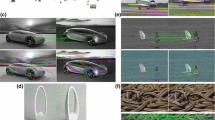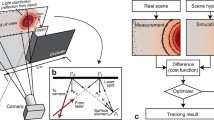Abstract
A method is presented for tracking general curved objects through 3-space, given a sequence of grey-level images. The explicit recovery of 3D features is avoided and results demonstrate the method to be stable, accurate and robust. The object model has two parts — a tracking model and a grey-level model; the former specifies which features of the object are tracked, and the latter determines the appearance of these features. The method assumes initial position is known. Visible features are tracked using correlation between their rendered appearance and the next frame, to give a set of disparities. These disparities are used to invert the perspective transform and give the new position of the object.
Access this chapter
Tax calculation will be finalised at checkout
Purchases are for personal use only
Preview
Unable to display preview. Download preview PDF.
Similar content being viewed by others
References
Bray A J. Tracking models using convergence techniques. CSRP 114, Sussex University, UK, 1988.
Bray A J. Tracking objects using image disparities. Proceedings of the 5th Alvey Vision Conference, Reading, 1989.
Bray A J. Recognising and Tracking Polyhedral Objects. PhD thesis, School of Cognitive and Computing Sciences, University of Sussex, UK, 1990.
Stephens R S. Real-time 3D object tracking. Proceedings of the 5th Alvey Vision Conference, Reading, pages 85-90, 1989.
Harris C and Stennettt C. RAPID — a video rate object tracker. Proceedings of the 1st British Machine Vision Conference BMVC, pages 73-77, 1990.
Lowe D G. Stabilised solution for 3D model parameters. The First European Conference of Computer Vision, 1990.
North P R J. Reconstruction of visual appearance. Proceedings of the 1st British Machine Vision Conference BMVC, pages 205-210, 1990.
North P R J. Optimal surface fusion (OSF). Proceedings of the 2nd British Machine Vision Conference BMVC, 1991.
Lowe D G. Three-dimensional object recognition from two-dimensional images. Artificial Intelligence, 31(3), 1987.
Worrall A D, Baker K D, and Sullivan G D. Model based perspective inversion. Proceedings of the 4th Alvey Vision Conference, Manchester, pages 13-18, 1988.
Nishihara H K. Practical real-time imaging stereo matcher. Optical Engineering, 23(5):536–545, 1984.
Author information
Authors and Affiliations
Editor information
Editors and Affiliations
Rights and permissions
Copyright information
© 1991 Springer-Verlag London Limited
About this paper
Cite this paper
Bray, A.J. (1991). Tracking Curved Objects by Perspective Inversion. In: Mowforth, P. (eds) BMVC91. Springer, London. https://doi.org/10.1007/978-1-4471-1921-0_20
Download citation
DOI: https://doi.org/10.1007/978-1-4471-1921-0_20
Publisher Name: Springer, London
Print ISBN: 978-3-540-19715-7
Online ISBN: 978-1-4471-1921-0
eBook Packages: Springer Book Archive




